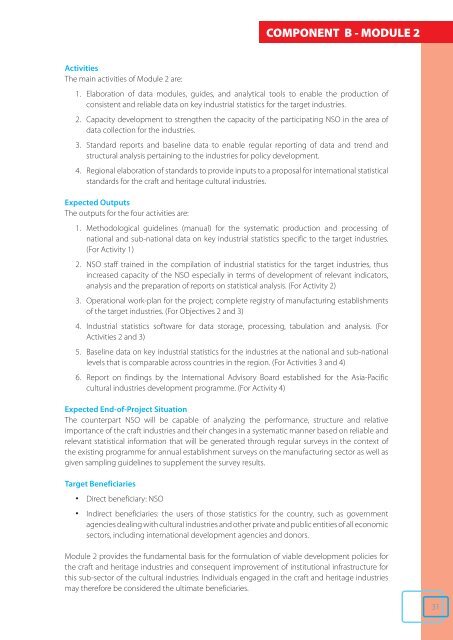Statistics on Cultural Industries - International Trade Centre
Statistics on Cultural Industries - International Trade Centre
Statistics on Cultural Industries - International Trade Centre
- No tags were found...
You also want an ePaper? Increase the reach of your titles
YUMPU automatically turns print PDFs into web optimized ePapers that Google loves.
COMPONENT B - MODULE 2ActivitiesThe main activities of Module 2 are:1.2.3.4.Elaborati<strong>on</strong> of data modules, guides, and analytical tools to enable the producti<strong>on</strong> ofc<strong>on</strong>sistent and reliable data <strong>on</strong> key industrial statistics for the target industries.Capacity development to strengthen the capacity of the participating NSO in the area ofdata collecti<strong>on</strong> for the industries.Standard reports and baseline data to enable regular reporting of data and trend andstructural analysis pertaining to the industries for policy development.Regi<strong>on</strong>al elaborati<strong>on</strong> of standards to provide inputs to a proposal for internati<strong>on</strong>al statisticalstandards for the craft and heritage cultural industries.Expected OutputsThe outputs for the four activities are:1.2.3.4.5.6.Methodological guidelines (manual) for the systematic producti<strong>on</strong> and processing ofnati<strong>on</strong>al and sub-nati<strong>on</strong>al data <strong>on</strong> key industrial statistics specific to the target industries.(For Activity 1)NSO staff trained in the compilati<strong>on</strong> of industrial statistics for the target industries, thusincreased capacity of the NSO especially in terms of development of relevant indicators,analysis and the preparati<strong>on</strong> of reports <strong>on</strong> statistical analysis. (For Activity 2)Operati<strong>on</strong>al work-plan for the project; complete registry of manufacturing establishmentsof the target industries. (For Objectives 2 and 3)Industrial statistics software for data storage, processing, tabulati<strong>on</strong> and analysis. (ForActivities 2 and 3)Baseline data <strong>on</strong> key industrial statistics for the industries at the nati<strong>on</strong>al and sub-nati<strong>on</strong>allevels that is comparable across countries in the regi<strong>on</strong>. (For Activities 3 and 4)Report <strong>on</strong> findings by the Internati<strong>on</strong>al Advisory Board established for the Asia-Pacificcultural industries development programme. (For Activity 4)Expected End-of-Project Situati<strong>on</strong>The counterpart NSO will be capable of analyzing the performance, structure and relativeimportance of the craft industries and their changes in a systematic manner based <strong>on</strong> reliable andrelevant statistical informati<strong>on</strong> that will be generated through regular surveys in the c<strong>on</strong>text ofthe existing programme for annual establishment surveys <strong>on</strong> the manufacturing sector as well asgiven sampling guidelines to supplement the survey results.Target Beneficiaries••Direct beneficiary: NSOIndirect beneficiaries: the users of those statistics for the country, such as governmentagencies dealing with cultural industries and other private and public entities of all ec<strong>on</strong>omicsectors, including internati<strong>on</strong>al development agencies and d<strong>on</strong>ors.Module 2 provides the fundamental basis for the formulati<strong>on</strong> of viable development policies forthe craft and heritage industries and c<strong>on</strong>sequent improvement of instituti<strong>on</strong>al infrastructure forthis sub-sector of the cultural industries. Individuals engaged in the craft and heritage industriesmay therefore be c<strong>on</strong>sidered the ultimate beneficiaries.31
















